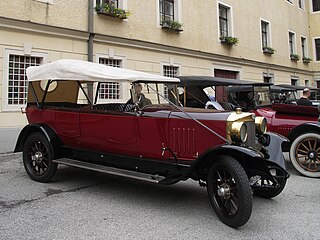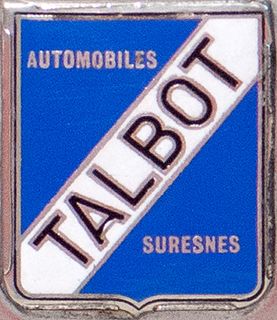History
Julien Belleville had been a maker of marine boilers from around 1850. Louis Delaunay joined the firm in 1867 and married Belleville's daughter. He changed his name to Delaunay-Belleville and succeeded his father-in-law in charge of the company. [2]
S.A. des Automobiles Delaunay-Belleville was formed in 1903 by Louis Delaunay and Marius Barbarou [ fr ]. Barbarou's family owned the boiler making company Belleville in Saint-Denis, with boiler design influences inspired by the company. Barbarou, then 28, [3] had experience working for Clément, Lorraine-Dietrich and Benz and was responsible for design and styling, including the trademark round grille shell. [4] The first car was exhibited at the 1904 Paris Salon, and it received enormous acclaim. [5]
The company started with three models, all four-cylinders: [6] a live axled 16 hp and a 24 hp and 40 hp model, both chain-driven. [7] These were likely the first automobiles to have pressure-lubricated camshafts. [8] The bodies were attached with just four bolts, and the brakes were water-cooled, from a 2 imp gal (9.1 l ; 2.4 US gal ) reservoir. [8]
Delaunay-Belleville were a prestige marque, and one of the world's leaders, from the outset, and by 1906, Emperor Nicholas II of Russia had purchased a 40. [8] Other royal owners included King George I of Greece and King Alphonso XIII of Spain.
The first French car maker to offer a six-cylinder engine, Delaunay-Belleville's 70 hp became available only in 1909, and then only in small numbers, remaining in limited production until 1912. [8] This model came to be known as the Type SMT, or Sa Majesté le Tsar, because Nicholas purchased one of the last 70s built. [8] He also ordered another in 1909; the demand for a silent starter, operable from the driving seat, became known as a Barbey starter, and was made standard at the end of 1910. [8]
Like most prestige marques, the cars were sold as bare chassis and bodies were coachbuilt for them. Between 1906 and 1914, British imports were mainly bodied by Shinnie Brothers, a Burlington Coachbuilders [9] subsidiary, in Aberdeen, then shipped to London for sale. [8]
Postwar, Continental bodies gained popularity, at least in Britain, as Belgium's D'Ieteren Frères became most associated with the company: their landaulette, on a 26 hp chassis, was priced in Britain at £900, pitting them between Napier and Rolls-Royce. [8]
In 1919, the company offered the P4, a 2 litre sidevalve 10 hp four-cylinder, undoubtedly the most expensive voiturette on the market, as well as a 2.6 litre OHC 15.9 hp four, the P4B, in 1922. [8]
After Barbarou resigned, Delaunay-Belleville quality began to slip. [8] New four-cylinder pushrod overhead valve 14/40 and 16/60 models appeared in 1926, and the pre-war 20 hp and 10 hp six-cylinder models continued to be produced until 1927. [8] The last gasps were the 3,180 cc (194 cu in) 21 hp six of 1928 and the 3,619 cc (220.8 cu in) 21/75 OHV six of 1930. In 1931, Continental engines, imported from the US, were offered, being quieter and cheaper. [8]
By the late 1920s, Delaunay-Belleville had lost its prestige, and converted to truck and military vehicle production. In 1936 the previously separate car company was merged with the Delaunay-Belleville parent. Production of the Delaunay-Belleville RI-6 continued through the late 1930s and was revived after the Second World War. This was a six-cylinder-engined car strongly resembling [8] the Mercedes-Benz 230, featuring independent suspension all-round; revived postwar, it featured Cotal preselector gearbox [8] and a front grille design apparently copied from the 1939 Buick. [10] However, the business was in decline: anyone buying a RI-6 in the 1940s would have done so in the knowledge after-sales service might disappear soon. [10] Six cars were completed in 1947 and only four during the first part of 1948. [10]
The company continued to advertise new cars for sale until 1950, but the factory was sold to Robert de Rovin in 1948 and thereafter used to make cyclecars. [8] [10]





















